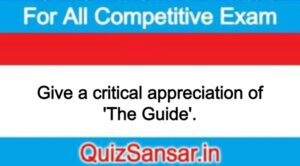
Give a critical appreciation of ‘The Guide’.
Give a critical appreciation of ‘The Guide’.
Ans.
R.K. Narayan’s “The Guide is a piece of aesthetic Art. So far as the style of description is concerned it is party romantic and largely realistic. A real picture of Indian villagers has been drawn by the novelist. The description of Malgudi, a developing town depicts the Indian Life and bolds a mirror to the economic life of the country. Nevertheless the writer is more concerned with the art than to show the standard of life. Besides the art there is a picture of the economic condition of the country.
An ordinary saint is the main character in The Guide’ and all the story moves around him. Raju the guide develops relation with Rosie, a tourist’s wife. But in the course of novel love proves to be curse. The destiny of the tourist guide is shaped according to the principle that ‘A wrong does must meet punishment he deserves.’ The education of other’s wife may not be an ideal but it creates something romantic in the heart of a reader. The way Rosie reacts against her guilty conscience, has psychological fact. Actions and reactions are arranged logically.
Narayan does not declare any moral purpose. He hits the aesthetic pattern on the social background and a concealed moral purpose. He has moral standard while creating The Guide. Source of his aestheticism may be seen in his designing the images. Romance between Rosie and Raju accelerates the aesthetic tone of the people.
‘The guide’ may be considered as a simple drama of a hero infatuated with love. The dramatic events have been incorporated in the novel. I(t has its beginning, middle and an end. Emphasis on the events and changing scenes of the novel generate the dramatic spirit in “The Guide’. The first meeting of Raju with Rosie is dramatic. The way in which she asks to see cobra dance in also dramatic. Dramatic irony can also be noticed in the changing fortunes of the hero.
Comic elements seems to be flowing along with the presentation of Kaju as a pseudo swami R.K. Narayan is supposed to be the greatest of Indo Anglian novelists. His humours are all pervasive and free from anger and bitterness. Narayan’s humour with a universal appeal qualified him to have a place in the main stream of the great comic tradition. Verghese remarks, “Narayan’s concept of humour covers a wide range from mere force and simple witticism to the irony of incongruous worlds.”
There is tragic impulse in the body of the novel ‘The Guide’. Marco, Rosie and Raju as swami are portrayed as tragic. Spirit of the novel is in its greyness; neither black nor white.
R.K. Narayan has a high sense of technique. He is expert in managing and ordering the events. He has control over his characters too. Intensity of Narayan’s art may be observed of such scenes as in the award of punishment of Raju.
Unlike others Narayan is not going to propagate any didactic or philosophical idea. He seems to be a supporter of old values. People should be cautious of the hypocritical saints. Marco belongs to the high culture and presents a contrast to the life general. Love is transferred to sensuality The passion recedes giving room to mere companionship. From the point of view of the theme Narayan is bold enough. In the words of Somadeva, ‘The novel, ac doubt, becomes more external than internal when a novelist takes the inside of the passions of the psychological level he improves its tone. But such is not the case with Narayan in ‘The Guide’. He gets possessed of the other facts of life which tend to enfeeble the theme. He begins with passion and ends with the change in destiny and downfall of the hero’.
“The Guide’ is a super creation of art by R.K. Narayan, but absence of agency to comment on the tragedy of the hero may be called as a technical flaw. However there are suggestions from Raju’s mother and Gaffur who advise that ne must not act in the way he does. The tragic hero lives on his own significance and has not support to climb upto lofty ideals. Secondly, surrender of Rosie to Raju’s desire is not a paying proposition. It disturbs the social order and balance of mind. The view of Narayan is traditional in this connection. The social obligations demand that a certain morality should be observed by the people. But the moral purpose is hidden behind visible art of the novelist.
Thus ‘The Guide’ is a mirror to the true social moral life of Malgudi in particular. On the whole ‘The Guide’ is pre-eminent and its uniqueness rests in its narrative and dramatic spirit.
-
Write the critical appreciation of the poem No. 12 entitled Far Below Flowed.
-
Write the critical appreciation of the poem No. 11 entitled Leave this Chanting.






